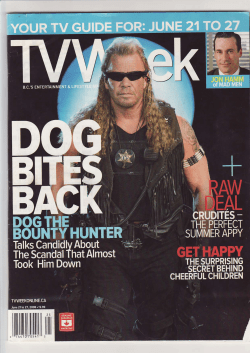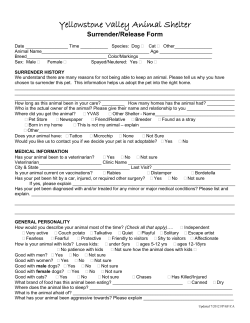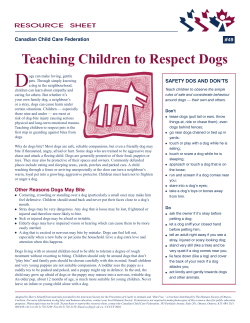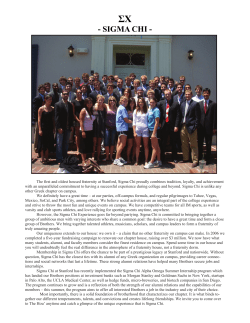
Document 94867
Presented by Kylie Jo Hirschy-Seivert AKC Junior Showmanship Judge #18875 chuckmunster99@sbcglobal.net 262.510.1359 Copyright 2009 Kylie Jo Hirschy-Seivert Junior Showmanship Copyright 2009 I look forward to assisting juniors and working with them in a way to show them how to succeed in junior showmanship. Here is a little bit about myself. Junior Showmanship is “close to my heart” as I showed extensively in that area when I was a teenager. Showing a Golden Retriever that I finished myself (CH Amberac’s U Can’t Tucker Him Out) and several Field Spaniels (CH OTCH Chevy, CH Demo, and CH CT Race), I earned national rankings through competition and defeating other juniors that included #1 Junior Handler with a Sporting Breed, #4 All Breed and, the highlight, #1 Junior Handler with a Golden Retriever along with #1 Junior Handler with a Field Spaniel. I currently breed Field Spaniels with my mom under the Calico prefix and compete in conformation, obedience, rally and hunting. A few words of advise is to create a team that can float around the ring, set up with confidence, listen to instructions, dress yourself and your dog for success, and the result is simply breath taking. I wish all juniors “good luck” in the ring! After all, the juniors of today are the breeders, exhibitors and judges of tomorrow. Kylie shown showing Ritz in the BBE Sporting Group at the 2008 Eukanuba Show in Long Beach, CA. After all, the juniors of today are the breeders, exhibitors and judges of tomorrow. Page 1 Presented by Kylie Jo Hirschy-Seivert AKC Junior Showmanship Judge #18875 chuckmunster99@sbcglobal.net 262.510.1359 Copyright 2009 Here are my Top 8 things I am looking for when I judge Junior Showmanship: 1. First Impression: A dog set up efficiently, confidently is clearly showcased, and an eye-catcher. You want to catch the judge’s attention by means of professionalism. 2. Handler/Dog Relationship: There is a genuine and affectionate relationship between the junior and the dog. Be sure to take time to play with your junior’s dog and develop a relationship. It will shine through in the ring and the judges notice the juniors that play with their dogs in the ring. It is also important to have water near the ring in large classes to keep the dog hydrated judges do notice the constant care for the dogs while in the ring. Take the time to play with your dog in the ring because the judges do notice the handler/dog team. This is a great way to show off your tricks for example begging, high fives and spins. 3. Grooming: A well-groomed dog shows preparation, and don’t forget the teeth! While it is a personal “picky point” for me in judging, when I examine a dog and see dirty teeth – well the dog is not being show-cased to the best of the juniors ability and it reflects a level of care for the dog. 4. Handling and Gaiting: It is very important to move smoothly with the dog so that your movements are not a distraction behind the dog. Your arm should not string the dog up in the air, but a nice loose lead does not mean the lead is draping in a swoop beneath the dog’s chin. The ideal “loose” lead is not really loose per se; it is actually similar to holding the reins of a dressage horse. 5. Listen to Instructions: When given specific instruction, the junior should comply efficiently and correctly. To do otherwise, simply shows that the junior is not listening well to instructions. 6. Individual Patterns: The top juniors do not drift all over the ring in gaiting their dog; they are able to focus and maintain a line, while at the same time being attentive to the dog and the judge. Learn to get a focal point and gait your dog toward that point. With practice, it becomes automatic and you no longer need to think about it. 7. Free Baiting: Isn’t for everybody or every kind of dog, but it can truly make the difference in how a junior places in a class. In judging juniors, a final observation is often to ask the juniors to gait the dogs around, individually, and then free bait them in the center of the ring. It is a very helpful keen competition to sorting out the class, so be prepared for it! 8. Dress for Success: Remember, you want to be the one in the Best Junior Handler photo! You do not need expensive outfits; when showing in juniors and to this day I often shopped Goodwill and EBay for bargain outfits. At a premier dog show from a fun match, National or State 4-H event bring out the real nice cloths that showcase the dog yourself and the dogs well. Remember to look “classy” and have that polished look judges are looking for to get that “first impression.” In other words “classy” can mean attractive, useful and comfortable. This isn’t the place for the prom dress with high-heeled shoes, but this is the place for comfortable flats. Also, remember to dress your age and that means no low-cut blouses or miniskirts. Junior Showmanship is a class that you will need to bend over so wear comfortable, but nothing revealing. Remember dress for success!!! After all, the juniors of today are the breeders, exhibitors and judges of tomorrow. Page 2 Presented by Kylie Jo Hirschy-Seivert AKC Junior Showmanship Judge #18875 chuckmunster99@sbcglobal.net 262.510.1359 Copyright 2009 The below information is from the American Kennel Club website www.akc.org Getting Started in Junior Showmanship The American Kennel Club licenses dogs shows (competitive exhibitions in which dogs are judged in accordance with an established standard of perfection for each breed) that test and evaluate the form and function of purebred dogs. In addition, at some shows the AKC offers classes which evaluate the abilities of the participant on the other end of the lead, the young handler. AKC Junior Showmanship classes offer youngsters the opportunity to: 1. Develop their handling skills 2. Learn about good sportsmanship 3. Learn about dogs and dog shows. Join the world of AKC Junior Showmanship! Juniors are important to the future of the sport of dogs and responsible dog ownership, and the more they learn, the more valuable they become. The values, attitudes and responsibility learned through Junior Showmanship will serve youngsters well throughout their lives. By putting time and effort into learning about their dog and how to present it, juniors are rewarded with a win. Who may participate Junior Showmanship classes are open to children from 9 to 18 years old and are divided into Novice and Open classes: All participants in Junior Showmanship classes must have an AKC Junior Showmanship Handler Number. Novice classes are for those children who, at the time entries close, have not won three (3) first-place awards in a Novice class at a licensed or member show. To qualify as a win, more than one child must be in competition in a class. The Novice class gives those children who are beginners a chance to gain experience and confidence apart from the more seasoned youngsters. Open classes are for those children having three or more first-place wins; these are the more experienced Junior Handlers. A beginner can learn how to present their dog more effectively by watching these talented youngsters in the ring. The classes may further be divided into: • • • Junior: At least 9 years old but under 12 years old on the day of the show. Intermediate: At least 12 years old but under 15 years old on the day of the show. Senior: At least 15 years old but under 18 years old on the day of the show. After all, the juniors of today are the breeders, exhibitors and judges of tomorrow. Page 3 Presented by Kylie Jo Hirschy-Seivert AKC Junior Showmanship Judge #18875 chuckmunster99@sbcglobal.net 262.510.1359 Copyright 2009 Judging criteria Juniors are judged on their ability to present, or handle, their dogs within the same formats and guidelines as those who compete in the breed ring. The quality of their presentation, not the dog, is judged. Juniors are encouraged to develop their handling abilities, dress appropriately, conduct themselves in a proper manner, and present their dog in a well-groomed condition. What about the dog? Any dog entered must be eligible to compete in dog shows or obedience trials. The dog must be owned by the child, a member of the child's family or member of his household. Many times junior showmanship classes are free (if the dog is entered in regular classes) or are offered at the reduced rate. How to get started The best way for prospective junior handlers to see what is involved in junior handling is to watch the Junior Showmanship classes at a dog show. They will see how children take part at all levels of competition, how they have developed friendships and have learned to compete and accept their wins and losses in a gracious manner. Talk to these young participants in our sport. You will be impressed by their knowledge, attitudes and their willingness to share their experiences with someone new to the sport. Another way to learn the basics is at your local dog club. Many clubs offer weekly handling classes. These informal sessions are conducted in a relaxed atmosphere and afford both dog and handler an opportunity to practice in a setting similar to an actual show. In order to receive Premium Lists (which detail date, location and judges of all classes at a particular show) for shows in your area, visit the Superintendent's office at any show. Or subscribe to the AKC Gazette and you will receive, as a part of your subscription, the Events Calendar, a monthly supplement that lists all the AKC events held throughout the country. Reference the American Kennel Club Website After all, the juniors of today are the breeders, exhibitors and judges of tomorrow. Page 4 Presented by Kylie Jo Hirschy-Seivert AKC Junior Showmanship Judge #18875 chuckmunster99@sbcglobal.net 262.510.1359 Copyright 2009 Depending on where you are competing will depend on what handling patterns that you can expect. In AKC, most judges follow the down and back, triangle and “L” pattern for their individual examinations. In 4-H, you can see a variety of handling patterns. The following charts are from the ASCA website: After all, the juniors of today are the breeders, exhibitors and judges of tomorrow. Page 5 Presented by Kylie Jo Hirschy-Seivert AKC Junior Showmanship Judge #18875 chuckmunster99@sbcglobal.net 262.510.1359 Copyright 2009 After all, the juniors of today are the breeders, exhibitors and judges of tomorrow. Page 6 Presented by Kylie Jo Hirschy-Seivert AKC Junior Showmanship Judge #18875 chuckmunster99@sbcglobal.net 262.510.1359 Copyright 2009 After all, the juniors of today are the breeders, exhibitors and judges of tomorrow. Page 7 Presented by Kylie Jo Hirschy-Seivert AKC Junior Showmanship Judge #18875 chuckmunster99@sbcglobal.net 262.510.1359 Copyright 2009 After all, the juniors of today are the breeders, exhibitors and judges of tomorrow. Page 8 Presented by Kylie Jo Hirschy-Seivert AKC Junior Showmanship Judge #18875 chuckmunster99@sbcglobal.net 262.510.1359 Copyright 2009 Reference: American Kennel Club www.akc.org ASCA Website www.asca.org After all, the juniors of today are the breeders, exhibitors and judges of tomorrow. Page 9
© Copyright 2025










